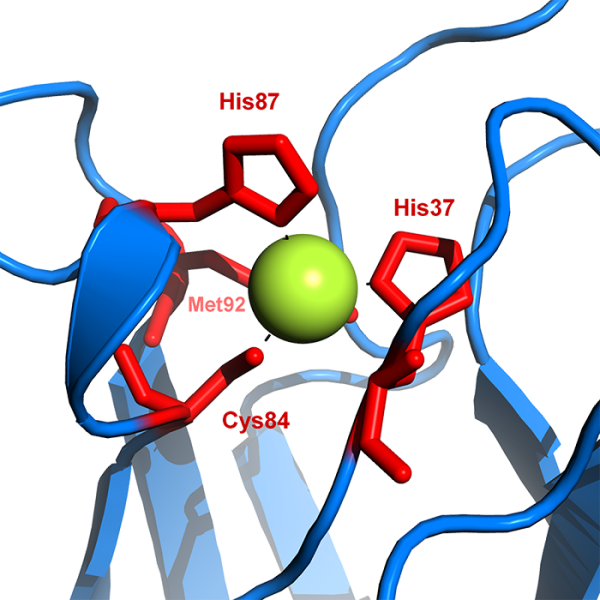Metalloproteins
Understanding metalloproteins

Metalloproteins are responsible for some of biology's most difficult and crucial functions. In most metalloproteins, the metal ion is coordinated via a nitrogen, oxygen, or sulfur atom that is part of the amino acid side chains. Half of all known proteins are classified as metalloproteins.
A subset of metalloproteins called metalloenzymes have the metal ion bound to a labile coordination site. Much effort has been made to understand the structure and function of metalloproteins, but one of the main problems is the inherent radiation sensitivity of the metal atoms or clusters these proteins contain.
Current issues to overcome
Synchrotrons are currently the most prevalent method for determining high-resolution structures of proteins, making use of high-energy X-rays to reveal the structure. A major roadblock with this method is the inherent ionizing effects of the X-ray beam, which changes the structure of the protein while the data are being collected.
Cryogenically cooling samples can help mitigate X-ray-induced radiation damage by increasing the amount of exposure before the damage effects become measurable. However, even at cryogenic temperatures, X-ray radiation produces site-specific damage around atoms that are sensitive to radiation damage.
These metalloproteins can suffer two types of damage, global damage and specific damage. Global damage is damage shown over the entire structure and usually manifests itself as a weakening of high-resolution diffraction. Specific radiation damage refers to changes seen in protein areas such as reduction of disulfide bonds, decarboxylation of amino acids, and most importantly, the redox state and chemical environment of transition metals.
Specific radiation damage impacting metal ions can cause difficulties when attempting to study reaction intermediates of metalloproteins, as it is hard to separate what structural changes might be from damage, and what is part of the actual enzymatic reaction. This damage typically occurs faster and at lower doses than global damage.
How LCLS can help
X-ray Free Electron Lasers (XFELs) like the Linac Coherent Light Source (LCLS) use ultrafast X-ray pulses to outrun global and specific radiation damage. Using microcrystals that can be anywhere in size from a few hundred nanometers to tens of microns, an intense, ultrafast X-ray FEL pulse destroys the crystal yet does so in such a short amount of time that any significant radiation damage is avoided.
Since multiple measurements using the same crystal are impossible, collecting a full dataset requires a serial approach as a new crystal must arrive at the x-ray interaction area before the next pulse. This enables the collection of a high-resolution data set from even extremely sensitive membranes and metalloproteins without any radiation damage.
To take things one step further, due to the lack of radiation damage and the short pulse duration of the X-rays it is possible to collect dynamic information from structural intermediates, even unstable ones.
For metalloproteins, it is not just the structure required to understand the function, but also the electronic structure and chemical environment surrounding the metal ions. LCLS also has a strong X-ray absorption spectroscopy program which can offer sensitive measurements of metal-metal and metal-ligand distances (Extended X-ray Absorption Fine Structure, EXAFS) as well as determining the coordination geometry and oxidation state (X-ray Absorption Near Edge Structure, XANES).
Latest publications
The following publications highlight how metalloproteins have been studied at LCLS:
- Ohmer et al. (2022) XFEL serial crystallography reveals the room temperature structure of methyl-coenzyme M reductase. J Inorg Biochem 230: 111768.
- Rabe et al. (2021) X-ray free-electron laser studies reveal correlated motion during isopenicillin N synthase catalysis. Sci Adv 7: eabh0250.
- Miller et al. (2020) The photoactive excited state of the B12-based photoreceptor CarH. J Phys Chem B 124: 10732-10738.
- Srinivas et al. (2020) High-resolution XFEL structure of the soluble methane monooxygenase hydroxylase complex with its regulatory component at ambient temperature in two oxidation states. J Am Chem Soc 142: 14249-14266.
- Miller et al. (2020) Artificial iron proteins: modeling the active sites in non-heme dioxygenases. Inorg Chem 59: 6000-6009.
- Artz et al. (2020) Tuning catalytic bias of hydrogen gas producing hydrogenases. J Am Chem Soc 142: 1227-1235.
- Lee et al. (2021) Ultrafast coherent motion and helix rearrangement of homodimeric hemoglobin visualized with femtosecond X-ray solution scattering. Nat Comm 12: 3677.
- Shelby et al. (2021) Interplays of electron and nuclear motions along CO dissociation trajectory in myoglobin revealed by ultrafast X-rays and quantum dynamics calculations. Proc Natl Acad Sci USA 118: 8966118.
- Reinhard et al. (2021) Short-lived metal-centered excited state initiates iron-methionine photodissociation in ferrous cytochrome c. Nat Comm 12: 1086.
- Fransson et al. (2021) Effects of x-ray free-electron laser pulse intensity on the Mn Kβ1,3 x-ray emission spectrum in photosystem II—A case study for metalloprotein crystals and solutions. Struc Dyn 8: 064302.
- Hussein et al. (2021) Structural dynamics in the water and proton channels of photosystem II during the S2 to S3 transition. Nat Comm 12: 6531.
- Keable et al. (2021) Room temperature XFEL crystallography reveals asymmetry in the vicinity of the two phylloquinones in photosystem I. Sci Rep 11: 21787.
- Ibrahim et al. (2020) Untangling the sequence of events during the S2 → S3 transition in photosystem II and implications for the water oxidation mechanism. Proc Natl Acad Sci USA 117: 12624.

